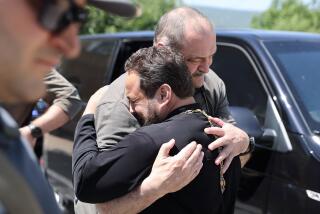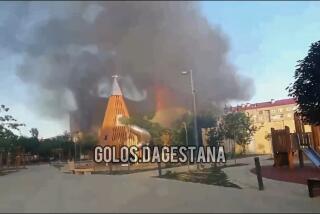Ethnic Riots Kill 37, Injure 80 in Soviet Asian Republic
- Share via
MOSCOW — Two days of rioting in the Soviet Central Asian city of Dushanbe has killed at least 37 people, Soviet state television and radio reported Tuesday, as mobs stormed and ransacked the Communist Party headquarters there, looted shops and clashed repeatedly with security forces in a new explosion of ethnic violence.
Soviet authorities deployed internal security troops, supported by armored cars and tanks, in an effort to halt the rioting, according to official news media, but the fighting only intensified, spreading to the suburbs.
“The situation in the town is out of control,” Radio Moscow reported in a late evening broadcast. “Skirmishes and fights were and are going on in more than 200 localities in the town.
“Pogroms, excesses and robberies are going on. According to preliminary estimates, 37 people were killed and 80 wounded since the beginning. Our forces are not enough. The state of emergency is not working.”
Six people had been confirmed killed during the first day of rioting Monday in Dushanbe, the capital of the republic of Tadzhikistan; this implied that at least 31 people were killed Tuesday, perhaps as troops assigned to restore order opened fire.
The rioting began Monday following an anti-government rally, the second in two days, protesting the rumored resettlement of 3,000 Armenian refugees from attacks in the Republic of Azerbaijan. The Armenians were to get housing ahead of the city’s Tadzhik population, according to the rumor.
Although government and party officials denied any such plan--there were fewer than 50 Armenian refugees in Dushanbe, all staying with relatives--emotions mounted rapidly as speakers demanded a “Tadzhikistan for the Tadzhiks,” according to Soviet newsmen who were present.
“Beat the Russians!” youths shouted as they began their rampage.
The assault on the party headquarters appeared from accounts of observers on the scene to be more than an attack on a handy target. With increasing shortages of food and most consumer goods, the party is taking increasing blame, even in such faraway places where its policies have rarely been questioned.
Ethnic strife is an increasing threat to the Soviet Union’s political and economic reforms. Conservatives blame President Mikhail S. Gorbachev for the growing violence and the serious social discontent that lies beneath it.
More than 200 people have been killed in the southern Soviet republics of Armenia and Azerbaijan in the Caucasus Mountains over the past month. Gorbachev sent thousands of soldiers into that area to end the anti-Armenian violence in the Azerbaijani capital of Baku and to put down what authorities later described as an attempt by the Azerbaijani Popular Front to seize power there, but now the troops in Baku are frequently the target of attacks themselves.
Ethnic tensions also were reported high in Frunze, capital of the neighboring republic of Kirghizia on the border with China, following rumors that Armenian refugees were to receive apartments in that city, the newspaper Komsomolskaya Pravda said. No violence was reported there.
Soviet state television, in a late-night report, showed clashes between rows of helmeted riot police and stone-throwing youths in Dushanbe. Two bodies lay on the street, fires were burning and widespread looting was in progress.
“The number of hooligan elements is getting larger every hour,” a Soviet television correspondent reported from the city, which lies about 1,600 miles southeast of Moscow. “The emergency measures are not working.”
Soviet authorities had declared a state of emergency in Dushanbe on Monday after rioters attacked the headquarters of the Tadzhikistan Communist Party the first time and then rampaged through the city. An overnight curfew is in force.
The number of wounded had grown to 108, according to the television report. About 30 people were arrested for taking part in the violence, the report stated.
A Tadzhikistan Interior Ministry official said by telephone from Dushanbe that the situation remained “very serious” Tuesday night, although the streets were quiet with the imposition of the curfew.
“We hope we can restore order in the morning,” he said, “but at this moment that is only a hope.”
In an appeal broadcast by Dushanbe Radio, Tadzhikistan’s Communist Party chief Kakhar Makhkamov called on residents to defend the city and its factories against “hooligans and plunderers.”
“All over the city today there are fires and pogroms, shops are being set on fire, glass is being broken, people are being beaten up,” Makhkamov said.
“I appeal to you, workers and Communists, I ask each one of you to defend his enterprise. Do not allow what has been done in 65 years in our capital to be destroyed in three days.”
The demonstrators elected a committee of 12 to represent them in negotiations with authorities on issues such as the current ethnic strife, housing and unemployment.
“Its ability to control an unruly crowd is in doubt,” a Soviet official said, “and we do not now understand everything they want.”
Interfax, a publication of official Radio Moscow, said the demonstrators demanded the deportation of all Armenians from Tadzhikistan; the closure of an ecologically dangerous aluminum plant; the return to the republic of all proceeds from cotton production, and the resignations of the Communist Party and government leadership.
There were reports that as many as 300 fearful Armenians were flown to Yerevan, capital of the Armenian Republic.
Soviet journalists, reporting earlier from Dushanbe, spoke of youths storming and ransacking the party headquarters, setting it on fire and then running wild in defiance of the internal security forces.
Yuri Zemmel, a correspondent for the Novosti press agency in Dushanbe, described the rioting as “truly horrible,” with the mobs, made up largely of young men, attacking virtually everything in sight and the outnumbered security forces opening fire with increasing frequency.
Zemmel said the clashes developed Monday when youths, not believing Makhkamov on the question of Armenian refugees, bombarded the party headquarters with volleys of stones and then began to storm it. Police fired warning shots, he said, but then began to shoot back when fired upon from adjacent buildings.
“I saw true madness in the inflamed eyes around me,” Zemmel said, recounting how the rioters, estimated to number more than 5,000, had spread through the center of Dushanbe.
“The mobs demolished post offices, shops, newsstands, whatever. Many were outright hooligans beating people they found in the street.”
TADZHIKISTAN AT A GLANCE The Land: Tadzhikistan, one of the Soviet Union’s 15 republics, covers 55,240 square miles and is bordered on the west by the Uzbekistan republic, on the north by the Kirghiz republic, on the east by Chinese Turkestan and on the south by Afghanistan. Its huge mountain glaciers are the source of many rivers, and the republic contains rich pasture lands. The People: Nearly 60% of the republic’s 4.8 million residents are Tadzhiks who speak an Iranian dialect little different from Persian, but most Tadzhiks are Sunni Muslims, not Shiites like the Iranians. About 23% of the people are Uzbeks, who live in the northwest, and 10.5% are Russian or Ukrainian. The Economy: The major occupations are farming, horticulture and cattle breeding, but large industrial enterprises have been established that include mining and textile factories. Tadzhikistan produces apricots, olives, figs, pomegranates and many other kinds of fruit. The Gissar sheep is famous for its meat and fat, and the Karakul for its wool. History: Tadzhiks are considered the descendants of the original Aryan population of Turkestan. The Tadzhik Soviet Socialist Republic was formed from those regions of Bokhara and Turkestan where most of the population was Tadzhik, and it became part of the Soviet Union on Dec. 5, 1929. Source: Associated Press
More to Read
Sign up for Essential California
The most important California stories and recommendations in your inbox every morning.
You may occasionally receive promotional content from the Los Angeles Times.













